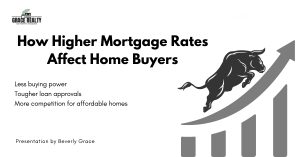Introduction: Why Everyone’s Talking About Mortgage Rates
If you’ve been thinking about buying or selling a home lately, you’ve probably noticed that mortgage rates are one of the hottest topics in real estate right now.
Rates have gone up and down a lot over the past few years — from record lows in 2020 to sharp increases in 2023 and 2024. In 2025, many people are wondering what’s next. Will rates drop again? Or will they stay high for a while?
Understanding how mortgage rates work — and how they affect both buyers and sellers — can help you make smart decisions in today’s housing market.
What Exactly Are Mortgage Rates?
A mortgage rate is simply the interest you pay your lender for borrowing money to buy a home.
Even a small difference in your rate can have a big impact on your monthly payment.
Example:
If you borrow $400,000 for 30 years, your monthly payment (before taxes and insurance) would be:
- About $2,398 at a 6% interest rate
- About $2,661 at a 7% interest rate
That’s a difference of $263 a month — or more than $3,000 a year.
What Affects Mortgage Rates in the U.S.?
Mortgage rates don’t move randomly — several big factors influence them:
- Federal Reserve policy: When the Fed raises or lowers its benchmark rate to control inflation, mortgage lenders often follow.
- Inflation: When prices are rising quickly, lenders raise rates to protect their returns.
- Economic growth: A strong economy can push rates higher, while slower growth tends to lower them.
- Bond market: Mortgage rates usually track the yield on 10-year U.S. Treasury bonds.
So when you hear that “the Fed raised rates” or “inflation is cooling,” it’s directly connected to what you’ll pay for your home loan.

How Higher Mortgage Rates Affect Home Buyers
Higher mortgage rates mean higher monthly payments. That can make it harder for many Americans to qualify for a loan or afford the kind of home they want.
Here’s what rising rates mean for buyers:
- Less buying power: A 1% rate increase can reduce your budget by around 10%.
- Tougher loan approvals: Lenders get stricter when monthly payments go up.
- More competition for affordable homes: As rates rise, more buyers focus on lower-priced listings.
Smart tips for buyers:
- Shop around: Don’t settle for the first lender — rates can vary.
- Lock your rate: Once you find a good one, lock it before it changes.
- Boost your credit: A better score means a better interest rate.
- Consider shorter loans or ARMs: A 15-year or adjustable-rate mortgage can save you money if you plan to move or refinance within a few years.
How Mortgage Rates Affect Home Sellers
For sellers, higher rates can mean fewer qualified buyers. When borrowing becomes more expensive, demand naturally slows down.
Here’s how that plays out:
- Fewer offers: Some buyers pause their search until rates drop.
- Longer days on market: Homes take longer to sell than they did during the low-rate boom.
- More price flexibility: Sellers may need to adjust pricing or offer incentives.
Tips for sellers in a high-rate market:
- Price your home based on local trends, not last year’s hot market.
- Offer buyer incentives like covering closing costs or helping buy down the buyer’s interest rate.
- Make your home move-in ready — updated kitchens, clean landscaping, and fresh paint go a long way.
What About Real Estate Investors?
Investors feel the impact of mortgage rates too.
- Higher financing costs can lower profits.
- Some investors turn to cash purchases or creative financing to avoid high interest.
- The rental market often gets stronger when buying becomes harder — more renters mean more demand for good rental homes.
If you invest in real estate, 2025 might be a time to focus on rental income and long-term gains rather than quick flips.
Future Trend: What Could Happen to Mortgage Rates in 2026?
No one can predict mortgage rates perfectly, but based on what experts are saying, 2026 could bring some relief.
Here’s what some major U.S. housing authorities expect:
- Freddie Mac predicts that 30-year mortgage rates could ease toward 5.5%–6.2% by the end of 2026.
- Fannie Mae sees a similar trend, assuming inflation continues to slow.
- The Mortgage Bankers Association expects rates to dip slightly as the economy stabilizes.
That means we may see:
- More affordable monthly payments for buyers.
- A stronger housing market as confidence returns.
- Increased competition once rates drop again.
So while 2025 might still feel like a “wait and see” year, 2026 could open new doors for many Americans hoping to buy their first home or move up to their next one.
How Buyers, Sellers, and Investors Can Prepare Right Now
Here are a few practical things you can do no matter your situation:
For Buyers
- Get pre-approved before you start shopping — it shows sellers you’re serious.
- Save for a larger down payment to lower your interest rate and monthly payment.
- Watch local markets closely — some cities may see prices soften even before rates drop.
For Sellers
- Focus on value — professional photos, good staging, and accurate pricing matter more than ever.
- Work with an agent who knows how to market your home effectively.
- Stay open to negotiations; buyers appreciate flexible sellers.
For Investors
- Look for areas with job growth and strong rental demand.
- Explore creative financing or partnerships to offset higher interest.
- Plan for the long term — buying in 2025 could look smart when rates ease in 2026.
Quick Recap: Key Takeaways
- Mortgage rates shape the U.S. housing market — they affect what people can afford and how homes are priced.
- In 2025, rates remain higher than a few years ago but may start to stabilize.
- 2026 could bring slightly lower rates if inflation and the economy continue to cool.
- Buyers, sellers, and investors can still succeed — with smart planning and realistic expectations.
Frequently Asked Questions (FAQs)
Q1: What’s the average mortgage rate in the U.S. right now?
As of fall 2025, the average 30-year fixed mortgage rate is between 6.5% and 7%, depending on your credit score, loan size, and lender.
Q2: Will mortgage rates go down in 2026?
Most experts think they’ll gradually drop through 2026, possibly landing near 5.5% if inflation stays under control.
Q3: How can I get the lowest mortgage rate?
Improve your credit score, save for a bigger down payment, and compare at least three lenders. Also, avoid new debt before you apply.
Q4: Do higher mortgage rates mean home prices will fall?
Not always. In many U.S. cities, limited housing supply keeps prices steady even when rates rise. But higher rates can slow down price growth.
Q5: Is 2025 a good time to buy a home?
Yes — if you find the right property and plan to stay for several years. You can always refinance later if rates drop.
Final Thoughts
Mortgage rates are the heartbeat of the U.S. housing market. They affect what buyers can afford, how sellers price their homes, and how investors plan for the future.
While 2025 is still a challenging year for affordability, there’s good news ahead. If forecasts hold true, 2026 may bring more balance — with slightly lower rates and stronger housing activity.
No matter where you stand, staying informed and working with a trusted real estate professional can help you make the most of today’s market — and prepare for tomorrow’s opportunities.





